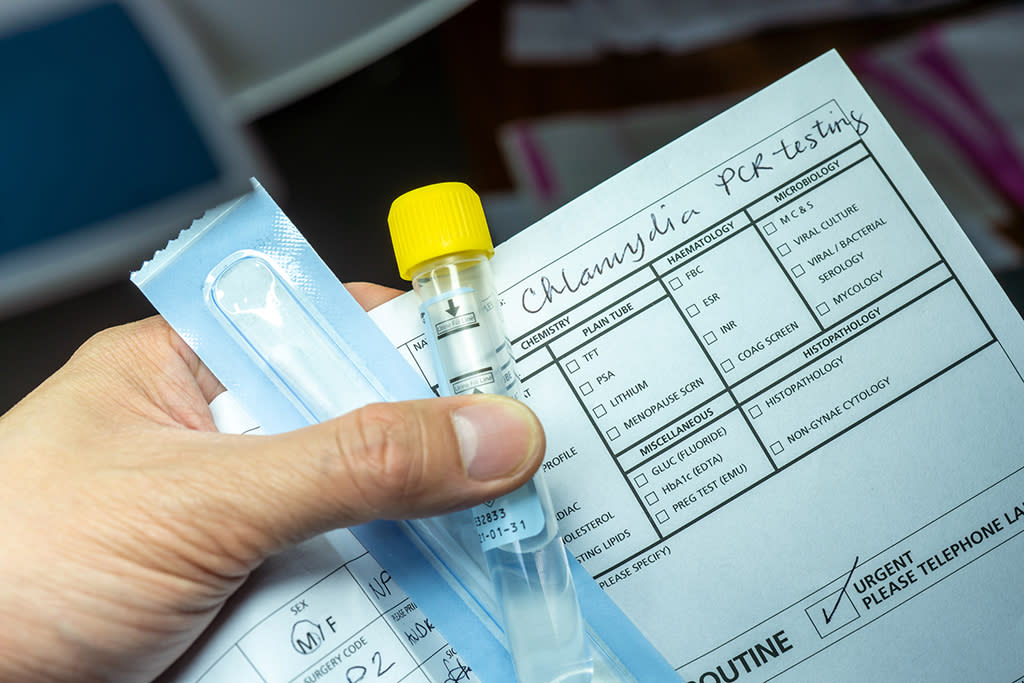3 STDs have skyrocketed in the U.S., new CDC report says — here’s what you need to know - Yahoo News
3 STDs have skyrocketed in the U.S., new CDC report says — here’s what you need to know - Yahoo News |
- 3 STDs have skyrocketed in the U.S., new CDC report says — here’s what you need to know - Yahoo News
- Don't give people gonorrhea for Christmas: health officials - New York Daily News
- When Strangers Diagnose You Online - Elemental
| 3 STDs have skyrocketed in the U.S., new CDC report says — here’s what you need to know - Yahoo News Posted: 21 Nov 2019 02:26 PM PST   Three STDs — gonorrhea, chlamydia and syphilis — have reached an all-time high in the U.S., according to a Centers for Disease Control and Prevention report. (Photo: Getty Images) The rates of three sexually transmitted diseases (STDs) — gonorrhea, chlamydia, and syphilis — have skyrocketed in the U.S., according to a new report from the Centers for Disease Control and Prevention (CDC). Jose Bazan, an associate professor of clinical internal medicine in the Division of Infectious Diseases at The Ohio State University Wexner Medical Center, tells Yahoo Lifestyle that the spike in STD rates is "alarming." The new Sexually Transmitted Disease Surveillance Report, which looked at data from 2017-2018, reveals concerning increases in the three most commonly reported STDs in the U.S., marking a dramatic turn. "Yet not that long ago, gonorrhea rates were at historic lows, syphilis was close to elimination, and we were able to point to advances in STD prevention, such as better chlamydia diagnostic tests and more screening, contributing to increases in detection and treatment of chlamydial infections," Gail Bolan, MD, director of the division of STD Prevention at the CDC, wrote in the foreword of the report. "That progress has since unraveled." Video: STDs at all-time high. How did we get here?What you need to know about these STDsChlamydia, which often has no symptoms, is the most commonly reported STD in the U.S., with 1.8 million cases. Rates of chlamydia have gone up by 19 percent since 2014. The highest rates of reported chlamydia cases in 2018 were among those 20–24 years old, followed by teens 15-19 years old. For gonorrhea, there are 583,405 cases in the U.S., and rates have gone up 63 percent since 2014. Gonorrhea is marked by burning or painful urination, as well as white, yellow or green discharge from the penis or increased vaginal discharge. Reported rates of the disease are highest in adolescents and young adults, specifically men and women aged 20-24 years old, according to the CDC report. With syphilis, there are 35,063 cases of primary and secondary syphilis in the U.S. Primary syphilis is marked by a sore or sores at the site of infection, while signs of secondary syphilis include a skin rash, swollen lymph nodes, and fever, per the CDC. Rates of syphilis have increased 71 percent since 2014, and are highest in men and women 25-29 years old. But what's even more concerning are the reported rates of congenital syphilis — when an infected mother passes syphilis to her baby during pregnancy — which have shot up by 185 percent since 2014, with 1,306 cases in the U.S. CDC's Bolan noted in a statement that 94 newborns died from congenital syphilis in 2018, calling it "the most alarming threat." "In addition to newborn death," Bolan added, "congenital syphilis can result in miscarriage or severe lifelong physical and neurological problems for the child." The report also noted that certain states have higher STD rates than others. For chlamydia, Alaska, along with the District of Columbia, have the highest rates in the nation, while West Virginia has the lowest rates. Mississippi and the District of Columbia have the highest rates of gonorrhea, while Vermont has the lowest. The District of Columbia and Nevada have the highest syphilis rates, while Vermont has the lowest. Although most states reported at least one case of congenital syphilis (the type that's passed from mother to baby during pregnancy), five states – Texas, California, Florida, Arizona, and Louisiana – make up 70 percent of all cases in the U.S., according to the report. Why STD rates are so high right nowSo what's going on? The CDC data show that there are several factors behind these rising STD rates. "These include cuts to STD programs at the state and local levels," Michael Cackovic, an ob-gyn at The Ohio State University Wexner Medical Center, tells Yahoo Lifestyle. "Over 50 percent of these local programs have experienced budget cuts resulting in clinic closures, reduced screenings, and inability to pursue patient follow-up." Other factors include increased drug use, poverty, and unstable housing, which Cackovic says leads to at-risk behaviors. Bazan also notes a decrease in condom use among at-risk patients, which has been linked to the rise in STDs. There are also some people who underestimate their chances of getting infected. "Many individuals believe that STDs won't happen to them, that they can identify potential at-risk partners, and if contracted, that they can be cured with a quick dose of antibiotics," says Cackovic, who notes that many don't realize the potential to transmit these infections, even if they do not have symptoms. What can people do to prevent the spread of STDs?First, get tested. "The most important first step that people take is to go get tested and be open with their healthcare provider about specific behaviors that can put them at risk for STDs," says Bazan. He explains that specific behaviors can put people at risk for STDs, such as having multiple sex partners, sex while using drugs, or not using protection such as condoms in non-monogamous relationships. He adds: "Providers need to ask all the appropriate questions in a sensitive and non-judgmental manner so patients feel safe and comfortable discussing issues related to STDs and sexual health. Providers also need to follow the most current STD screening and treatment guidelines provided by the CDC." Cackovic recommends condom use to reduce the risk of infection. To help lower the rates of congenital syphilis, he points out that it's especially important for expectant mothers to be screened as part of good prenatal care to "help reduce this burden to the newborn." If left untreated, STDs can have several negative health consequences. "For example, chlamydia and gonorrhea can cause pelvic inflammatory disease in women, which in turn can lead to ectopic pregnancy, infertility, and chronic pelvic pain," says Bazan. "Syphilis can involve basically any organ in the body and can cause meningitis, blindness, and hearing loss, among many other things. Pregnant women with syphilis can also pass the infection to their unborn babies, which can result in stillbirth and congenital syphilis." Read more from Yahoo Lifestyle: Follow us on Instagram, Facebook and Twitter for nonstop inspiration delivered fresh to your feed, every day. |
| Don't give people gonorrhea for Christmas: health officials - New York Daily News Posted: 27 Nov 2019 11:22 AM PST [unable to retrieve full-text content]Don't give people gonorrhea for Christmas: health officials New York Daily News |
| When Strangers Diagnose You Online - Elemental Posted: 27 Nov 2019 04:10 AM PST
Another reason users flock to social media is speed: Nearly 90% of posts on the STD forum received a response, the researchers found, often in less than a day. Compare that to an average wait time of 24 days for new patients to get in to see a doctor. In the case of STDs, anonymity is another motivator. "Despite STDs being super, super common, it's still stigmatized," explains Nobles, the study's lead author and a research fellow at UCSD's Department of Medicine. She adds that on any given day, there are almost twice as many Americans walking around with an active HPV infection than the flu. "People may be going on there because they feel more comfortable speaking with a stranger than their doctor." "With the doctor there is always a fear of being judged, dismissed, or feeling minuscule," writes Reddit user Lime_Soda678, described as an 18-year-old gay Nigerian man living in Canada. After hooking up with a few guys from Grindr, he panicked about having possibly contracted HPV and/or HIV but felt he couldn't talk about it with his conservative parents or his family doctor. In the r/STD forum, he found empathy, and he credits the community with educating him on things he didn't know before. "Some people on the Reddit aren't exactly professionals, but as I continue to learn about STDs, I have gained some higher knowledge, which I share with people who are new to the community," he writes. "I guess it works in that cycle: We're all just sharing the knowledge we have acquired, which is, most of the times, correct." Public health officials would take issue with that claim. The JAMA study didn't look at the accuracy of the diagnoses being meted out on forums like r/STD, but you can imagine they wouldn't all pass muster with the CDC. (One user suggested treating genital warts with lizard feces.) "From a public health perspective, it's incredibly concerning," says Adriane Casalotti, chief of government and public affairs for the National Association of County and City Health Officials (NACCHO), which represents 3,000 local health departments across the country. She notes that the vast majority of people who have an STD don't have symptoms anyway. "So, off the bat, crowd-diagnosing really misses a great deal of cases," she says. Though easily cured with antibiotics, STDs like gonorrhea and chlamydia, when left untreated, can lead to infertility, while syphilis can cause neurologic and ocular infections, as well as miscarriage and stillbirth.
Stranger still, about one in five posts on r/STD were from people who had already been diagnosed by a professional and were looking for a second opinion, the study found. "This could indicate that there's more health care providers can and should be doing to better engage with our patients to process those things in the room, versus folks feeling like they have to go and second-guess what their diagnosis was," Casalotti acknowledges. "It also points to the continued need for comprehensive, evidence-based, nonjudgmental sex education so people feel more confident in their health literacy." This is where researchers like Nobles and Ayers see opportunity. While the conventional response to those who consult "Dr. Google" is scolding disapproval, there's a lot to be gained by studying the health-related questions people are posting and searching about on the internet. Data from search engines and social networking sites has already been used to predict things like flu outbreaks and spiking demand for IUDs after the 2016 election. "This is a naturally organic thing that's happening, and by being aware, we can intervene," says Ayers, citing Reddit's SuicideWatch forum as a hopeful example. There, volunteers triage posters and guide them to professional, lifesaving help. "That's had a tremendous benefit to society," he says. "If we could do this for other conditions, that'd be amazing." |
| You are subscribed to email updates from "std pictures" - Google News. To stop receiving these emails, you may unsubscribe now. | Email delivery powered by Google |
| Google, 1600 Amphitheatre Parkway, Mountain View, CA 94043, United States | |

Comments
Post a Comment